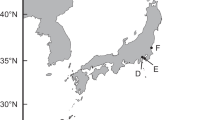Abstract
The seasonal accumulation of the amnesic toxin domoic acid (DA) in the tissues of two commercial species of bivalves from Vostok Bay (the Sea of Japan) was assessed for the first time. The concentration of domoic acid in the tissues of the Pacific mussel Mytilus trossulus varied from 0.003 to 0.1 mg/kg during the period between October and February, and in the scallop Mizuhopecten yessoensis it varied from 0.003 to 0.09 mg/kg during the period between January and March. The maximum concentration of domoic acid in both species of mollusks was recorded in January. The results indicate the need for year-round monitoring of amnesic toxin concentrations in bivalves from Vostok Bay.
Similar content being viewed by others
REFERENCES
Mogilnikova, T.A., Motylkova, I.V., and Konovalova, N.V., On the massive occurrence of common toxic species of phytoplankton and the phytotoxin content in tissues of the scallop Mizuhopecten yessoensis Jay in coastal waters of Sakhalin Island, Tr. Sakhalin. Nauchno-Issled.Inst. Rybn. Khoz. Okeanogr., 2007, vol. 9, pp. 207–222.
Stonik, I.V. and Orlova, T.Yu., The species composition and quantitative distribution of the diatom genus Pseudo-nitzschia H. Peragallo, 1900 in Russian waters of the Sea of Japan and the Sea of Okhotsk, Russ. J. Mar. Biol., 2013, vol. 39, no. 4, pp. 238–245.
Official Methods of Analysis of AOAC International, 19th ed., Latimer, G.W., Jr., Ed., Gaithersburg, Md.: AOAC Int., 2012,
Bates, S.S., Hubbard, K.A., Lundholm, N., et al., Pseudo-nitzschia, Nitzschia, and domoic acid: New research since 2011, Harmful Algae, 2018, vol. 79, pp. 3–43.
Bricelj, V.M. and Shumway, S.E., Paralytic shellfish toxins in bivalve molluscs: Occurrence, transfer kinetics, and biotransformation, Rev. Fish. Sci., 1998, vol. 6, pp. 315–383.
Kleivdal, H., Kristiansen, S.-I., Nilsen, M.V., and Goksøyr, A., Determination of domoic acid toxins in shellfish by Biosense ASP ELISA—A direct competitive enzyme-linked immunosorbent assay: Collaborative study, J. AOAC Int., 2007, vol. 90, pp. 1011–1027.
Lee, J.H. and Baik, J.H., Neurotoxin-producing Pseudonitzschia multiseries (Hasle) Hasle, in the coastal waters of Southern Korea. II. Production of domoic acid, Algae, 1997, vol. 12, pp. 31–38.
Lelong, A., Hégaret, H., Soudant, P., and Bates, S.S., Pseudo-nitzschia (Bacillariophyceae) species, domoic acid and amnesic shellfish poisoning: revisiting previous paradigms, Phycologia, 2012, vol. 51, pp. 168–216.
Orlova, T., Morozova, T., Kameneva, P., and Shevchenko, O., Harmful algal blooms on the Russian east coast and their possible economic impacts, in Proc. Workshop on Economic Impacts of Harmful Algal Blooms on Fisheries and Aquaculture, Trainer, V.L. and Yoshida, T., Eds., PICES Scientific Report, no. 47, Sidney: PICES, 2014, pp. 41–58.
Orlova, T.Yu., Kameneva, P.A., Stonik, I.V., et al., Diarrhetic shellfish toxins in Primorsky Krai, Russia, J. Shellfish Res., 2015, vol. 34, no. 3, pp. 1151–1160.
Stonik, I.V., Orlova, T.Yu., Chikalovets, I.V., et al., Pseudo-nitzschia species (Bacillariophyceae) and the domoic acid concentration in Pseudo-nitzschia cultures and bivalves from the northwestern Sea of Japan, Russia, Nova Hedwigia, 2019, vol. 108, nos. 1–2, pp. 73–93.
Trainer, V.L., Bates, S.S., Lundholm, N., et al., Pseudo-nitzschia physiological ecology, phylogeny, toxicity, monitoring and impacts on ecosystem health, Harmful Algae, 2012, vol. 14, pp. 271–300.
Funding
This research was supported by the Dal’ny Vostok Project no. 18-5-074.
Author information
Authors and Affiliations
Corresponding author
Ethics declarations
Conflict of interests. The authors declare that they have no conflict of interest.Statement on the welfare of animals. All applicable international, national, and/or institutional guidelines for the care and use of animals were followed.
Additional information
Translated by T. Koznova
Rights and permissions
About this article
Cite this article
Stonik, I.V., Orlova, T.Y. The Seasonal Accumulation of Amnesic Toxin (Domoic Acid) in Commercial Bivalves Mytilus trossulus Gould, 1850 and Mizuhopecten yessoensis Jay, 1850 in Vostok Bay, Sea of Japan. Russ J Mar Biol 46, 56–58 (2020). https://doi.org/10.1134/S1063074020010083
Received:
Revised:
Accepted:
Published:
Issue Date:
DOI: https://doi.org/10.1134/S1063074020010083




